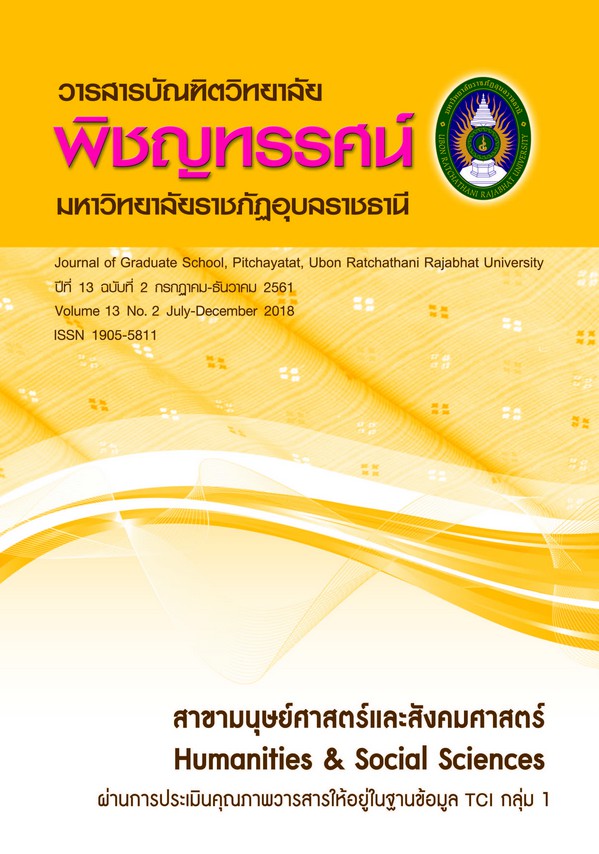รูปแบบการท่องเที่ยวเชิงนิเวศวัฒนธรรมลุ่มน้ำชีเพื่อการอนุรักษ์และพื้นฟูวิถีชีวิตชุมชน ตำบลชีทวน อำเภอเขื่องใน จังหวัดอุบลราชธานี
คำสำคัญ:
รูปแบบการท่องเที่ยวเชิงนิเวศวัฒนธรรม, การอนุรักษ์และการฟื้นฟูวิถีชีวิตและศักยภาพของชุมชนบทคัดย่อ
งานวิจัยนี้มีวัตถุประสงค์เพื่อ 1) ศึกษาประวัติศาสตร์ท้องถิ่น ตำนานความเชื่อ และบริบทชุมชนรวมทั้งวิถีชีวิตชาวประมงลุ่มน้ำชีจากอดีตจนถึงปัจจุบัน 2) ศึกษาศักยภาพของชุมชนและแหล่งท่องเที่ยวในพื้นที่ และ 3) หารูปแบบการท่องเที่ยวเชิงนิเวศวัฒนธรรมลุ่มน้ำชีเพื่อการอนุรักษ์และฟื้นฟูวิถีชีวิตของชุมชนในพื้นที่ตำบลชีทวน อำเภอเขื่องใน จังหวัดอุบลราชธานี ใช้กระบวนการวิจัยเชิงปฏิบัติการแบบมีส่วนร่วม PAR (Participatory Action Research) โดยเป็นการทำงานร่วมกันระหว่างนักวิชาการกับทีมนักวิจัยชุมชนเจ้าของพื้นที่ ผลการศึกษาพบว่า 1. ชุมชนมีประวัติศาสตร์ท้องถิ่นที่น่าสนใจโดยสามารถแบ่งประวัติศาสตร์ออกเป็น 4 ยุค ได้แก่ ยุคตั้งบ้าน (พ.ศ.2460-2464) ยุคแยกบ้าน (พ.ศ.2465-2537) ยุคเทคโนโลยีในชุมชน (พ.ศ. 2538-2552) และยุคแย่งชิงทรัพยากร ตั้งแต่ปีพ.ศ.2553 เป็นต้นมา 2. ชุมชนมีศักยภาพด้านการท่องเที่ยวโดยพบแหล่งท่องเที่ยวที่ยังคงความสมบูรณ์ 2 ประเภท ได้แก่ 1) แหล่งท่องเที่ยวทางธรรมชาติ และ2) แหล่งท่องเที่ยวทางวัฒนธรรม ชุมชนมีบุคลากรที่มีศักยภาพโดยพบว่ากลุ่มคนที่เข้ามามีบทบาทในการจัดการท่องเที่ยวส่วนใหญ่เป็นกลุ่มวัยกลางคนและผู้สูงอายุที่เป็นทั้งอดีตผู้นำและปราชญ์ชาวบ้าน 3. รูปแบบการท่องเที่ยวเชิงนิเวศวัฒนธรรมลุ่มน้ำชีเพื่อการอนุรักษ์และฟื้นฟูวิถีชีวิตที่เหมาะสมสอดคล้องกับบริบทของชุมชนสามารถจัดได้ 9 ฐานการเรียนรู้ ได้แก่ฐานเรียนรู้ที่ 1 วัดอัมพวันนาราม ฐานเรียนรู้ที่ 2 ดอนปู่ตา โฮงอ้อย ฐานเรียนรู้ที่ 3 ธรรมาสน์สิงห์ วัดศรีนวลแสงสว่างอารมณ์ ฐานเรียนรู้ที่ 4 วัดธาตุสวนตาล ฐานเรียนรู้ที่ 5 วัดทุ่งศรีวิไล ฐานเรียนรู้ที่ 6 ขัวโบราณ ฐานเรียนรู้ที่ 7 วัดป่าท่าเค็ง ฐานเรียนรู้ที่ 8 ล่องเรือลำน้ำชี และฐานเรียนรู้ที่ 9 หาดท่าหลวง หาดสบนก และหาดเต่าโตนซึ่งเป็นหาดทรายที่อยู่ตามรายทางของการล่องเรือ เมื่อนำมาจัดรูปแบบการท่องเที่ยวชุมชนตำบลชีทวนที่เหมาะสมกับศักยภาพและบริบทของพื้นที่ สามารถทำได้ 2 รูปแบบ ได้แก่ รูปแบบที่ 1 รายการนำเที่ยวแบบครึ่งวัน (เช้า หรือ บ่าย) ซึ่งสามารถจัดฐานการเรียนรู้ได้ประมาณ 3 – 4 ฐาน การเรียนรู้ รูปแบบที่ 2 รายการนำเที่ยวแบบเต็มวัน (ไม่ค้างคืน) ซึ่งสามารถจัดฐานการเรียนรู้ได้ประมาณ 8 – 9 ฐานการเรียนรู้ การจัดการท่องเที่ยวโดยผ่านกระบวนการวิจัยเชิงปฏิบัติการได้ทำให้เกิดผลดีแก่ชุมชน ได้แก่ 1) ความสามัคคีในชุมชน 2) อาชีพเสริมจากการท่องเที่ยว 3) ความสัมพันธ์และการมีส่วนร่วมของคนในชุมชน 4) ความตระหนักของคนในชุมชนในการอนุรักษ์ทรัพยากรรวมทั้งการเห็นคุณค่าของทรัพยากรท้องถิ่นและ 5) การเพิ่มศักยภาพของผู้สูงอายุให้มีบทบาทในการเป็นผู้นำของชุมชน
เอกสารอ้างอิง
บุญเลิศ จิตตั้งวัฒนา. แนวคิดการจัดการการท่องเที่ยว. เชียงใหม่: คณะมนุษยศาสตร์ มหาวิทยาลัยเชียงใหม่, 2548.
พจนา สวนศรี. คู่มือการจัดการท่องเที่ยวโดยชุมชน. กรุงเทพฯ: โครงการท่องเที่ยวเพื่อชีวิตและธรรมชาติ, 2548.
ภราเดช พยัฆวเชียร. การวางแผนตลาดการท๋องเที่ยว. เชียงใหม๋: มหาวิทยาลัยเชียงใหม่, 2543.
รำไพพรรณ แก้วสุริยะ. เอกสารการสอนชุดวิชา ความรู้เบื้องต้นเกี่ยวกับอุตสาหกรรมท่องเที่ยว. [ม.ป.ท]: มหาวิทยาลัยสุโขทัยธรรมาธิราช, 2549.
สินธุ์ สโรบล. การท่องเที่ยวโดยชุมชน : แนวคิดและประสบการณ์พื้นที่ภาคเหนือ. เชียงใหม่: สำนักงานกองทุนสนับสนุนการวิจัย (สกว.), 2546.
สุพรรณ ประเสริฐศรี. ผู้นำชุมชน (สัมภาษณ์) ปราชญ์ชาวบ้าน หมู่ 4 บ้านท่าศาลา ตำบลชีทวน อำเภอเขื่องใน จังหวัดอุบลราชธานี, 2 กันยายน 2558.
สำนักงานปลัดกระทรวงท่องเที่ยวและกีฬา.แผนพัฒนาการท่องเที่ยวแห่งชาติ ฉบับที่ 2 (พ.ศ. 2560-2564). กรุงเทพมหานคร: สำนักงานกิจการโรงพิมพ์องค์การสงเคราะห์ทหารผ่านศึก, 2560.
Ahmad Fitri Amir et al. Sustainable tourism development: A study on community resilience for rural tourism in Malaysia. Centre for Environment-Behavior Studies (eE-Bs). Proceeding of Asia Pacific International Conference on Environment-Behaviour Studies; 24-26 February 2014; Berlin.
Florentina Daniela Matei (Titilina). Cultural tourism potential, as part of rural tourism development in the North-East of Romania. Academic World Research and Education Center Proceeding of 2nd Global Conference on Business, Economics Management and Tourism; 30-31 October 2014; New York.
Richards, G. Cultural tourism: A review of recent research and trends. Journal of Hospitality and Tourism Management. 36 (2018): 12-21.
Sudesh Prabhakarana, Vikneswaran Naira and Sridar Ramachandran. Community participation in rural tourism: Towards a conceptual framework. The Scientific Committee of 5AEC2014 5th Asia Euro Conference; 2014; New York.
ดาวน์โหลด
เผยแพร่แล้ว
รูปแบบการอ้างอิง
ฉบับ
ประเภทบทความ
สัญญาอนุญาต
บทความทุกเรื่องได้รับการตรวจความถูกต้องทางวิชาการโดยผู้ทรงคุณวุฒิภายนอกอย่างน้อย 3 คน ความคิดเห็นในวารสารพิชญทรรศน์เป็นความคิดเห็นของผู้นิพนธ์มิใช่ความคิดเห็นของผู้จัดทำ จึงมิใช่ความรับผิดชอบของวารสารพิชญทรรศน์ และบทความในวารสารพิชญทรรศน์สงวนสิทธิ์ตามกฎหมายไทย การจะนำไปเผยแพร่ต้องได้รับอนุญาตเป็นลายลักษณ์อักษรจากกองบรรณาธิการ





